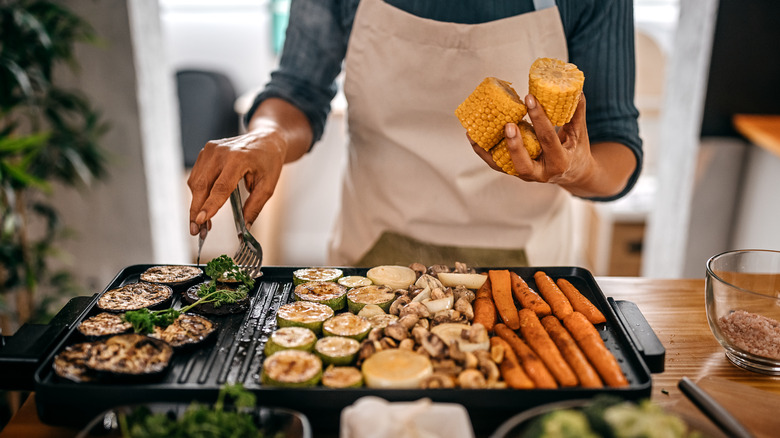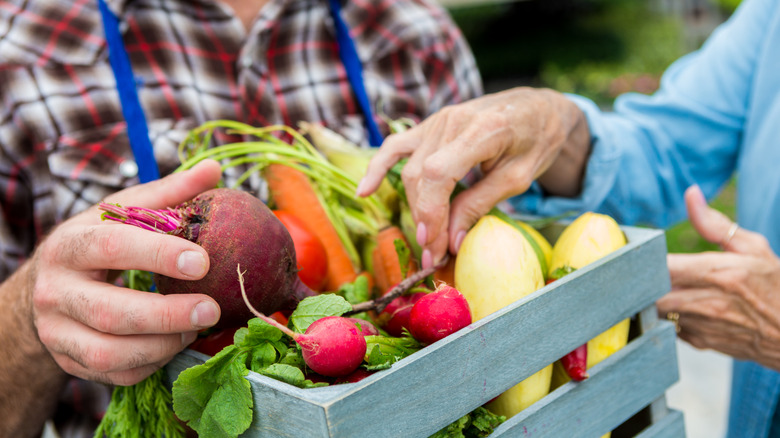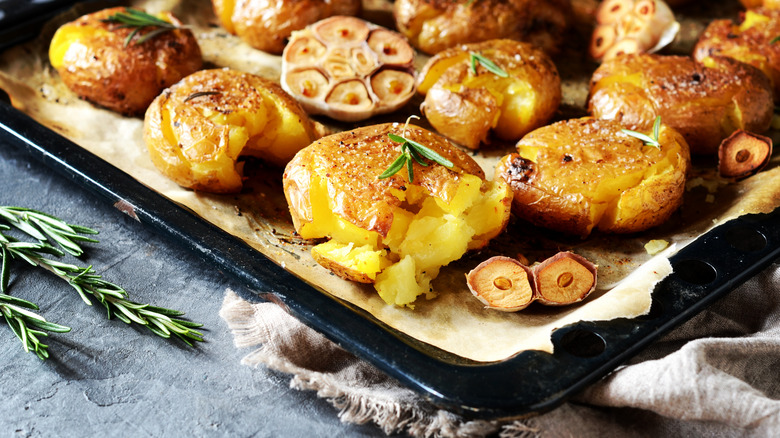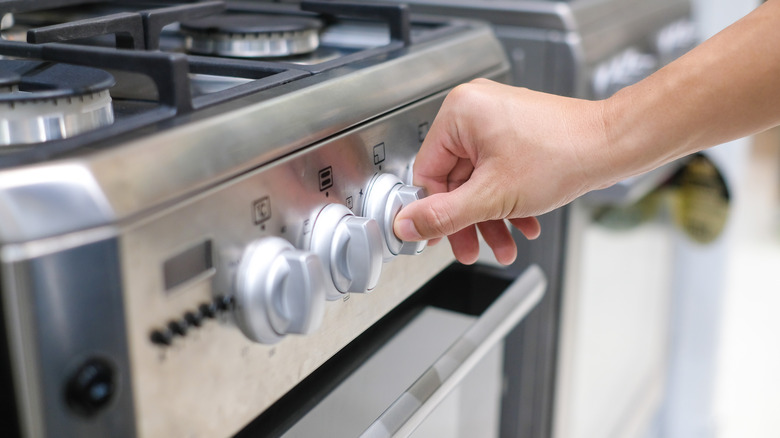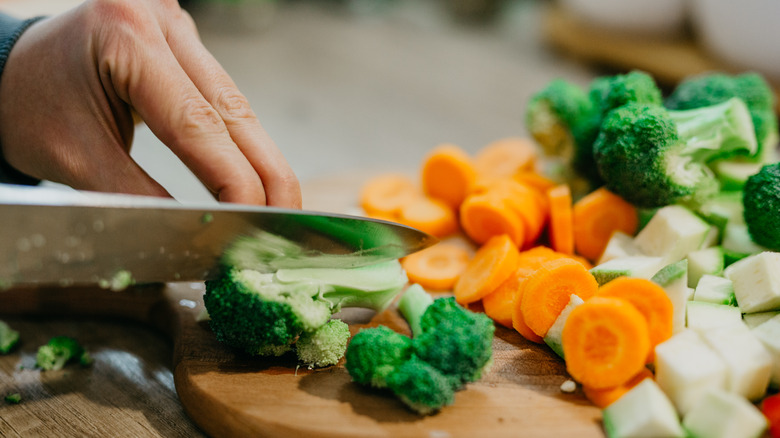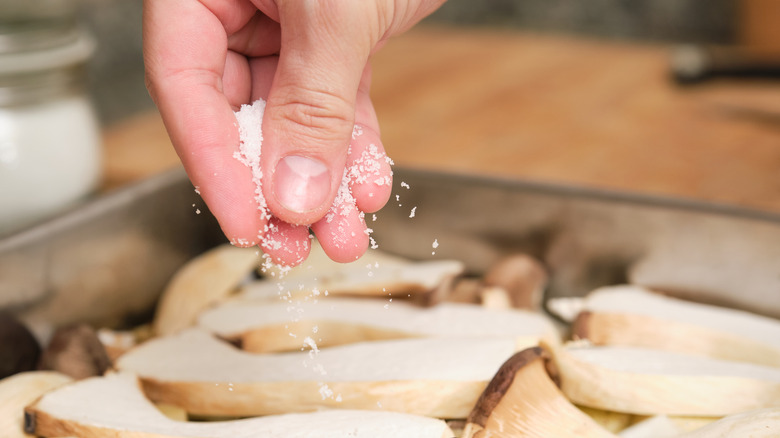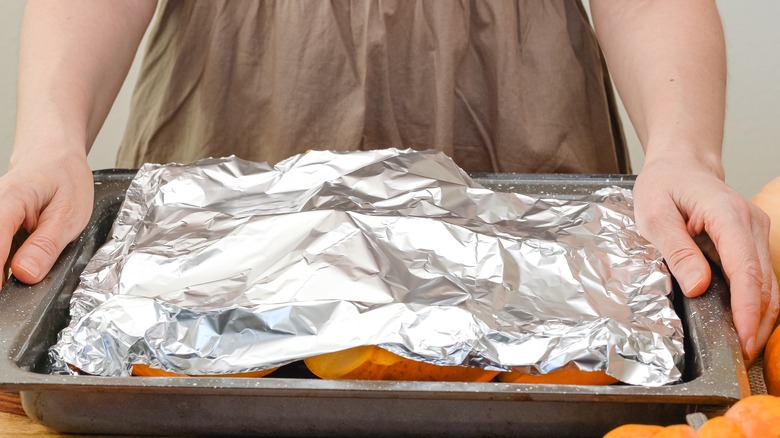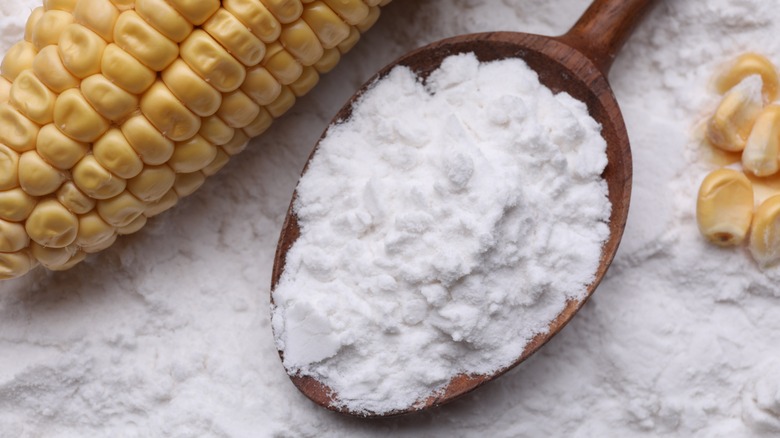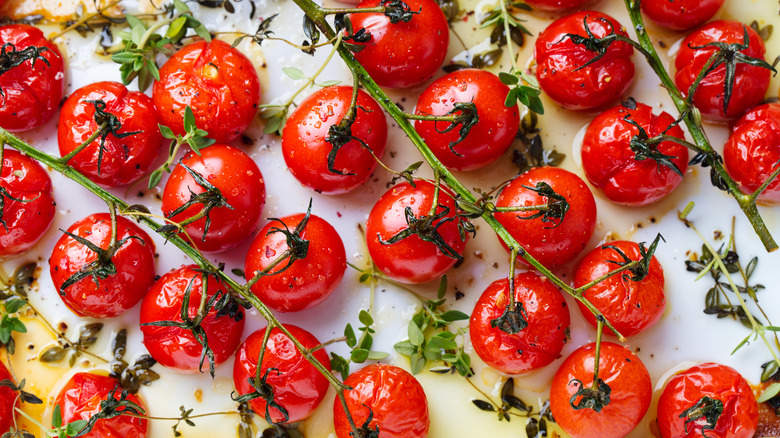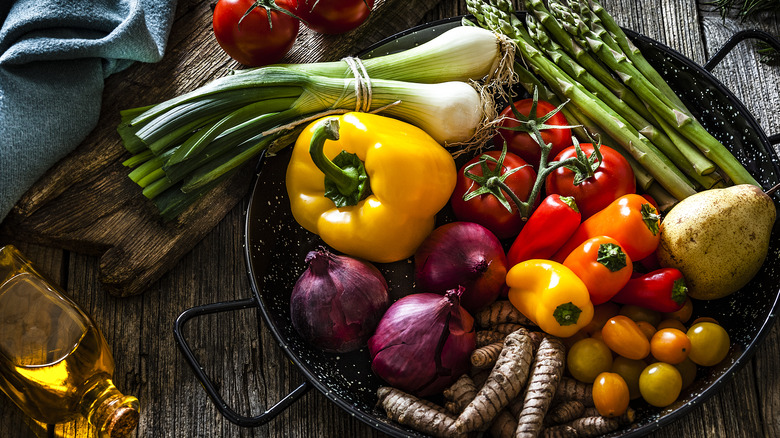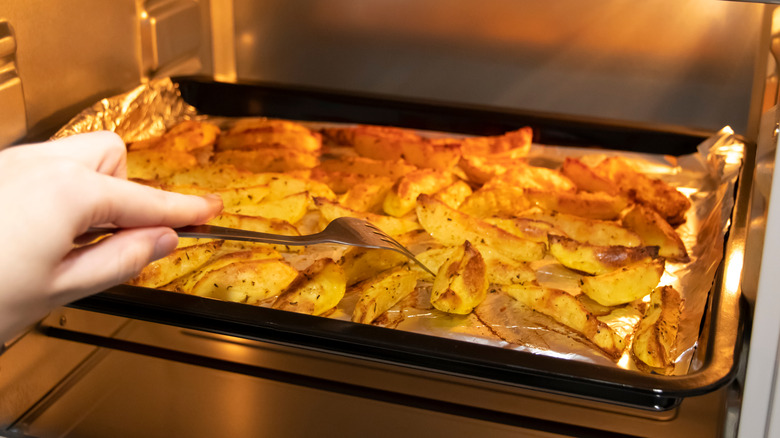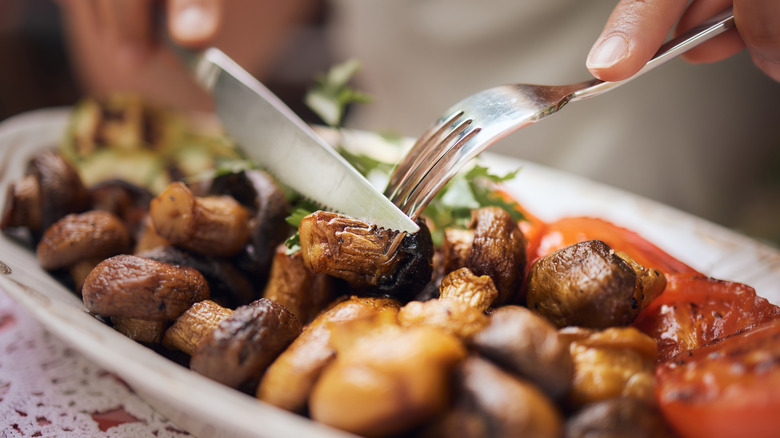How To Roast Your Vegetables To Perfection Every Time
Are you currently suffering from floppy vegetables? Soggy squash? Stringy asparagus that's oddly raw and also charred to smithereens? With a few little adjustments, you'll be making perfect roasted veggies and bragging about it to everyone around the dinner table — well, maybe you should hold off on bragging and just feel confident. Truthfully, you don't need to be a domestic genius to whip up a killer tray of roasted vegetables.
We've got tips and tricks to land you in the home cook's hall of fame for World's Best Roasted Vegetables on a Random Tuesday — even a weird blah Thursday. Because imagine this: A beautiful bounty of roasted red onions, entire heads of garlic, carrots with their tops still on, colorful baby potatoes, bright green Brussels sprouts, a sprinkling of fresh dill, asparagus, mushrooms, and zucchini, all cooked to perfection any day of the week! Someone take a pic of us stat with these gorgeous beets — and say cheese! Wait, how did a glass of wine get in there? Now let's get roasting!
Get seasonal
In-season veggies pack the most flavorful punch — and the method of roasting will highlight the taste of your produce. So if you don't have fresh veggies to begin with, you'll be hard-pressed to roast them to perfection. The produce that thrives in that toasty oven heat are root veggies like carrots, potatoes, and yams, as well as other hearty heroes such as cauliflower, onions, and Brussels sprouts (with bacon, of course, always with bacon!). When these types of tubers and bulbs appear at the farmer's market, that means they're in-season, and ready for their closeup ... in the oven!
Typical grocery stores in the United States have all kinds of veggies like zucchini, radishes, or fennel at any time of the year. An extremely wide variety of produce is available all year long in the States, thanks to regions where farms (and greenhouses) are constantly in production. But sourcing your roast-friendly root veggies during the winter months when they're naturally in-season means they'll taste their absolute best — and even better once they come out of the oven! For real, why do we waste our time eating vegetables any other way?
Pick your perfect pan
You probably already have a baking sheet in mind for roasting your veggies. (Thumbs up!) But the type of oven tray you're using definitely influences the final outcome of your dish. For our culinary purposes, we want a pan that's thick and also great at holding heat. "Any sheet pan can be used to roast, but the best ones are typically the heavier options that don't lose their heat as quickly when you open the oven door to check up on them," chef Luis Cuadra told Oprah Daily. It's as if he knows we like to peek at our progress.
There are all sorts of options — basically any baking sheet that's not paper thin will do — but some pans work better for certain tasks. Want extra crispy veg? Go with cast iron. Want effortless non-stick? Grab a silicone mat to top your tray. While people go back and forth on whether parchment paper and aluminum foil liners ruin the crisp factor, or whether they're still worth it for the easy cleanup, experts agree that a roasting pan needs rimmed edges to catch any juicy drippings.
Top-notch temps
It ain't really roasting unless it's 400 degrees Fahrenheit! But, truthfully, you can play around within the range of 375 to 450 degrees. (And also because vegetables need that slight variation in temperature in order to cook their best.)
While all roasting requires that you bring the heat, don't forget to turn down the dial for big, sturdy produce like potatoes or squash. Those types of veggies need more time in the oven so that everything cooks all the way through without simultaneously burning on the outside. Got smaller sizes of these items? Or a delicate veg like zucchini? Crank it up, baby! Those tiny-sized, or water-packed guys cook fast, so you want them to get a nice caramelization before they need to come out of the oven.
Hot tip: Pop your baking sheet in the oven while your range is preheating. That way, as soon as those veggies hit the warm pan (not a cold one), they'll be sizzling' like a fried egg on a hot sidewalk. Sizzling like an electrical wire in a lightning storm. Sizzlin' fo' shizzlin'. (Okay, okay, we're terrible with colloquial expressions, but genius with roasted veggies!) Just, you know, do it!
Chop it like its hot
Roasted vegetables are kind of the fix-it-and-forget-it of veggie dishes. But a little handy prep can help a lot. If you're working with whole produce, chop up your veg into sizes that will be happy in the oven. Quick rule of thumb on this? Everything should be relatively the same size, once chopped. And if you just got a little woozy while reading that, hold on, because the reason isn't so complicated.
Uniform sizing allows all of your veggies to cook at relatively the same rate. Which means less little blackened souls of former broccoli florets, and no sweet potato insides that are still raw and crunchy. Winning.
For the big stuff like onions, carrots, and potatoes, aim for roughly 1 inch square pieces. For mini red potatoes or Brussels sprouts, cutting them in half should do the trick. For those veggies in the skinny 'n' long family — asparagus, we see you — they can go in whole. And then send a little prayer up to the convection gods of the back of the oven that those itty bitty asparagus tips make it out cooked to perfection.
Salt before you roast
After digesting a solid decade of non-stop chef shows, where culinary wizards season the world's finest food to perfection, we're well-aware that salt's a thing. And yet, many of us forget this step completely, in a rush to get the food in the oven. So slow down and grab your seasoning — you always want to shake or sprinkle some on before you roast those veggies. The right amount of salt coaxes out the most dynamic flavor. But it's not the only reason to use it.
Salt also pulls extra H20 out of water-heavy vegetables like zucchini, which are basically made of 90 percent water. And that gives you crispy — not mushy — results. It also brings out flavor molecules that intensify whatever produce you're cooking. If you want more salty flair, you could try a salt-roasted (also called salt-baked) veggie dish. This involves burying root vegetables in salt, which then imparts seasoning during the cooking process. It's debatable whether or not salt-roasting is more about the buzzy presentation — it's definitely a fun one — with pan-roasting being an easier way to get the same job done. Bottom line: Season those veggies before you roast them.
Don't cover up your veggies
Do not be afraid of exploding roasted grape tomatoes. And whatever you do, don't cover your vegetables in aluminum foil, or any other lids — because covering them with a foil tent results in a steamy situation. Not a tasty, toasty one.
Foil traps any moisture that might be pulled from the veggies, and then kind of humidifies them as they bake — it's like they're in a steam room. What do you get when your veggies go for a schvitz? Mush. You get mush. Gloppy, goopy mush. Yeah. Not good.
To get those golden brown edges and beautiful crispy, caramelized bits, the veggies must remain fully exposed to the heat. No exceptions! Oh. Except garlic. You can roast an entire head of garlic by chopping off the top of the bulb, brushing the exposed cloves with olive oil, covering it in foil (this is the one exception), and roasting it for 40 minutes, or until the cloves are soft and creamy. In this case, the foil keeps that papery skin from becoming, you know, basically like a flaming fireball in your oven. You're so very welcome for this trick — it makes us giddy with joy!
Get crispier with cornstarch
Do you order your French fries extra-crispy? Do you only like the protein bars with the crunchy bits? And do you find smoothies to be a little too ... uh, smooth? If you like to use your teeth to eat your food, you can get even crispier roasted veggies with cornstarch. And you know what's better? It's super easy.
So, what exactly is cornstarch? First things first: Martha Stewart says we should always have it on hand. And if she says it, you know it must be true! It's a corn-derived thickening agent that appears in soups, stews, and fried chicken. But it also works with roasted vegetables. And lucky us, that's exactly what we're talking about.
Here's how to do it. After you chop your veggies, pat them with a clean towel until they're as dry as humanly possible. This prevents any dreaded cornstarch clumps. Next, toss your veggies with your seasoning of choice, then add 1 tablespoon of cornstarch for every pound of vegetables, and toss until everything is coated. Roast until they're ready, and then never go back to not using cornstarch ever again. It's that simple.
Give 'em some space
Roasted veggies like their personal space. And they do best when they're not piled up on a baking sheet ... unlike literally every social media post of a tray of roasted vegetables, ever! Go ahead and check, we'll wait right here. (But spoiler alert: Instagram isn't 100 percent realistic. Also, eggplant is a fruit. And, well, half of us can't stop thinking about the Roman Empire but that's a separate story.)
Along your quest to achieve zero-mush, never-limp, crispy vegetal specimens, spread out your veggies on the tray in a single layer. In an ideal world, none of the vegetables would be touching, so that oven heat can circulate freely among the cauliflower and red peppers, for example. In reality, it's all good if a few of the pieces are closely flirting.
What if there's too many vegetables for one batch? Grab a second sheet pan. Or roast your produce in shifts — grouped into same-veggie pans. The goal is for each bite-sized piece to achieve its ultimate existence as that awesomely crispy, flavorful, once-in-a-lifetime bite. After bite. After bite ... and so on. You get the idea!
Get healthy with fat
Another sometimes forgotten step in veggie roasting prep involves the addition of quality fats. And a generous drizzle of olive oil gives you that flavorful, tender bite you're looking for. Plus, eating healthy fat allows your body to use the valuable vitamins in the vegetables. Also it's delicious! Do we need any more reasons? Because we can give you more, but how much time do we really have?
Just toss your chopped veg with 1 tablespoon of oil for each pound of raw produce. Many home cooks recommend doing this by hand so you can gently rub the oil into the vegetables as you go. You'll also be able to feel for any spots you may have missed.
As far as the best kind of oil to use? Stick with extra virgin olive oil, grass-fed ghee, avocado oil, and even liquid coconut oil — which all have smoke points around, or above, 400 degrees Fahrenheit. That means even at those toasty oven-roasting temperatures, these oils won't oxidize (a process which can damage your health over time) under the heat. They also maintain their tasty flavor profiles. For the most neutral of the bunch, avocado oil is your best option.
Flip it to win it
So, remember back when we said this was a fix-it-and-forget-it situation? Well, it almost is. Except for the part where the veggies need to be flipped half-way through their roast. (And they're, like, terrible at doing it themselves.) That's where you come in with your neat-o spatula, kitchen tongs, and that cool oven mitt shaped like a lobster claw.
Hands-down, the best part of a roasted vegetable is its crispy bottom — the part that comes in contact with the baking sheet. Well, what if we told you that you could have two crispy bottoms with one on top! Or three, with one on the side! (Apologies, we're having a hard time guessing exactly how you cut your radishes.)
Basically, just pop open the oven half-way through the cooking process, and either flip each piece upside down, or kind of rustle up your vegetables so they're not in the same position. What you're doing is exposing additional sides of each veggie to the hot pan. And this will make your veggies turn out perfect, because they'll be scrumptious no matter which side you bite into first.
Revive your leftover roasties
Consider this a public service announcement: You can revive your beautiful veggie medley from last night, even though it's cold and weird and all the crispy bits got soggy in the Tupperware. We were so excited to find out that we could enjoy our roasties two days in a row, instead of tossing them into a green salad and drowning them in ranch. No offense, Hidden Valley — we're huge fans, but not this time.
To crisp them back to life, grab that baking sheet, spread those leftover veggies out on parchment paper, and let them roast in the oven for about 10 minutes. You can also stir-fry them in a pan, or air-fry them back to life. Just don't throw them in the microwave where they will become even softer and floppier. That's the opposite of how we want to relive our parsnip dreams. With a little time spent with some dry heat, your roasted veggies will taste like the good old days (which was totally just yesterday) in no time.

